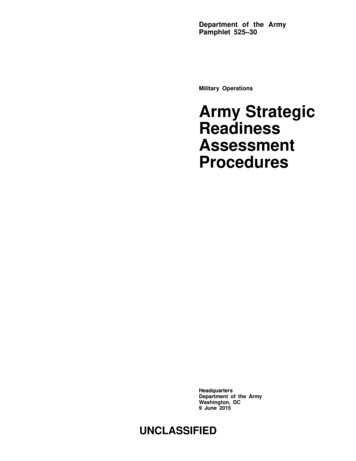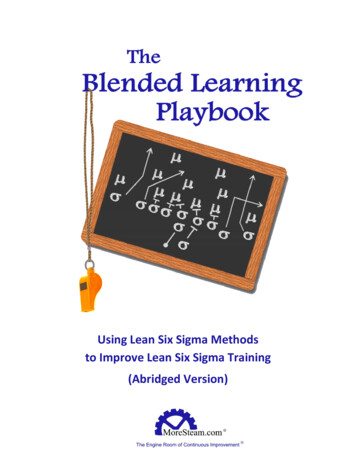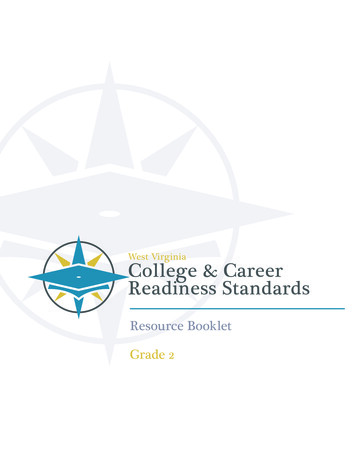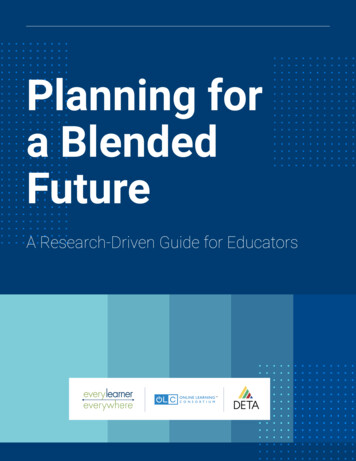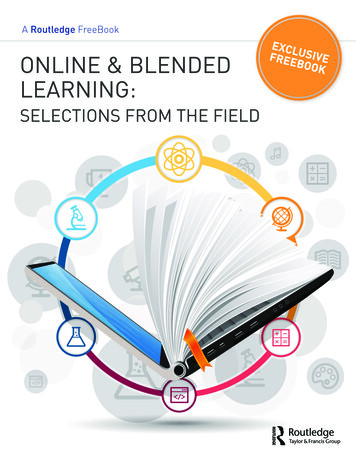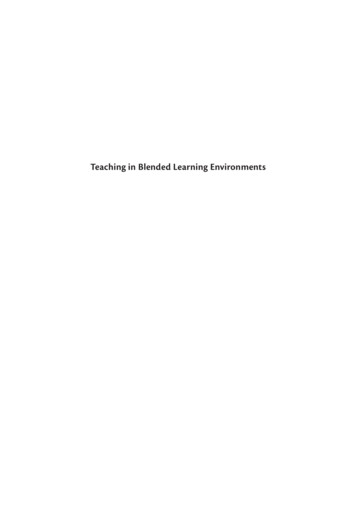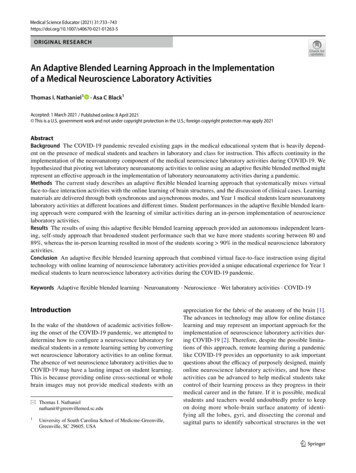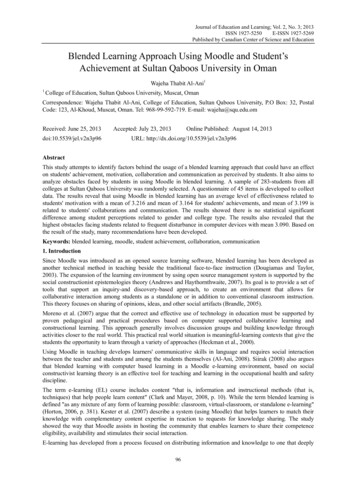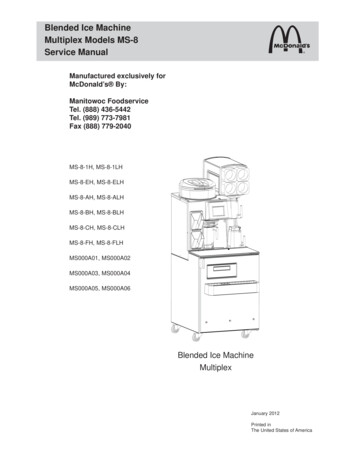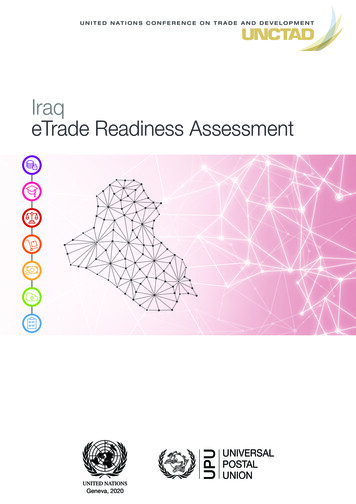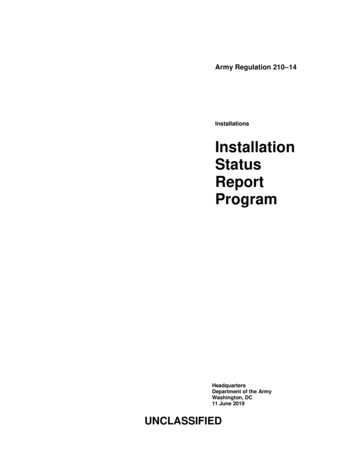
Transcription
K-12 BlendedTeaching ReadinessPhase 1Instrument DevelopmentO C TO B E R 2 0 1 7Written ByCharles R. GrahamBrigham Young UniversityJered BorupGeorge Mason UniversityEmily PulhamBrigham Young UniversityRoss LarsenBrigham Young University
K-12 Blended Teaching Readiness: Phase 1 - Instrument DevelopmentAbout Michigan Virtual Learning Research InstituteIn 2012, the Governor and Michigan Legislature passed legislation requiring Michigan VirtualTM,formally Michigan Virtual University , to establish a research center for online learning andinnovation. Known as Michigan Virtual Learning Research Institute (MVLRI ), this center is anatural extension of the work of Michigan Virtual. Established in 1998, Michigan Virtual’s mission isto advance K-12 digital learning and teaching through research, practice, and partnerships. Towardthat end, the core strategies of MVLRI are: Research – Expand the K-12 online and blended learning knowledge base through highquality, high impact research;Policy – Inform local, state, and national public education policy strategies that reinforceand support online and blended learning opportunities for the K-12 community;Innovation – Experiment with new technologies and online learning models to fosterexpanded learning opportunities for K-12 students; andNetworks – Develop human and web-based applications and infrastructures for sharinginformation and implementing K-12 online and blended learning best practices.Michigan Virtual dedicates a small number of staff members to MVLRI projects as well as augmentsits capacity through a fellows program drawing from state and national experts in K-12 onlinelearning from K-12 schooling, higher education, and private industry. These experts work alongsideMichigan Virtual staff to provide research, evaluation, and development expertise and support.Suggested Citation: Graham, C. R., Borup, J., Pulham, E., & Larsen, R. (2017). K-12 Blended Teaching Readiness: Phase 1Instrument Development. Lansing, MI: Michigan Virtual University. Retrieved VLRI.ORG1
K-12 Blended Teaching Readiness: Phase 1 - Instrument DevelopmentExecutive SummaryBlended learning is on the rise in K-12 schools (Picciano & Seaman, 2009; Miron & Gulosino, 2016;Molnar, 2017). With this growth in demand for blended learning, there is a greater need to prepareteachers who can facilitate successful learning in these environments.In order for educator preparation programs, districts, and schools to conduct effective professionaldevelopment for future blended teachers, the unique competencies of blended teaching need to beidentified. Additionally, organizations and teachers need to have an easy way to assess teacherreadiness and be able to diagnose what knowledge and skills they should focus on first in order tohave the greatest impact with their limited professional development time and resources.In this manuscript, we report on Phase 1 of a project intended to create a scientifically validated,openly-available blended teaching readiness instrument that can be freely used by districts,schools, and individual teachers to assess core knowledge and skills needed for successful blendedteaching. During Phase 1, we report on the following progress toward our goal: We report on the major patterns that we found in the existing competencies and identifylimitations of the existing work.We used the literature and expertise of current researchers and practitioners in the field todevelop an initial instrument for testing.We tested the instrument with over 200 teachers of various backgrounds in a large schooldistrict in the eastern United States.We used confirmatory factor analysis to test the fitness of two models using four commonstructural equation modeling (SEM) analyses and found good fit for one model and poor fit for asecond model.We make recommendations for Phase 2 of the study which includes adding an additionalsection to the model that focuses on management of blended classrooms as well as pursuing thedevelopment and testing of a second shorter instrument focused on pedagogy for organizationsand individuals not willing to invest time to complete the longer instrument.MVLRI.ORG2
K-12 Blended Teaching Readiness: Phase 1 - Instrument DevelopmentIntroductionA few years ago, the Utah State Board of education updated teacher licensure requirements toinclude the need for coursework preparing teachers “to teach effectively in traditional, online-only,and blended classrooms” and “to facilitate student use of software for personalized learning” (UtahAdministrative Code R277-504-4.C.3.c-f, n.d.). We also recognized national trends toward blendedand personalized learning highlighted by reports and policy recommendations from iNACOL(Patrick, Worthen, Frost, & Gentz, 2016). Furthermore, we became aware of blended andpersonalized learning initiatives at the school district level (see FCPS, n.d.). This led us to search forwhat specific competencies teachers would need for these environments that are distinct from theskills they are already learning or have already developed for teaching in traditional classrooms.While most traditional educator preparation programs require coursework related to technologyintegration, they require very limited training related to online teaching (Archambault et al., 2014;Barbour et al., 2012; McAllister et al., 2016) and supply very limited data on blended teachingpreparation for pre-service and in-service teachers. This report shares research that stemmed fromthe Phase 1 efforts of a MVLRI fellowship with the goal of developing an openly availableinstrument for identifying blended teaching readiness that could be used to inform professionaldevelopment and training for both preservice and in-service K-12 teachers.Growth in Blended LearningBlended learning is the combination of both online and traditional classroom instruction (Graham,2006; 2013). The past decade has seen significant growth in the adoption of blended and onlinelearning across K-12, higher education, and corporate training sectors. Blended learning is quitedifficult to track for three reasons: (1) there are many different models of blended learning; (2)often, blended learning is initiated by teachers without a formal school program; and (3) mostschools do not collect data about blended learning implementation. Despite these limitations,several studies have tried to document the extent of blended learning growth in K-12 schools. A 2008 survey of U.S. school district administrators (N 808) reported that 41% wereimplementing blended learning at some level, with 21% planning to implement blendedlearning within three years (Picciano & Seaman, 2009).A 2016 report from the National Education Policy Center (NEPC) using publicly availabledata identified 87 full-time blended schools (45 charter and 41 district-run) enrolling over26,000 students in 16 states (Miron & Gulosino, 2016).A 2017 NEPC report identified a 40% increase in student enrollments at full-time blendedschools, from 10,490 to 36,605, between 2014 and 2015 (Molnar, 2017).There is evidence that blended learning may even be more pervasive than current data indicate. Forexample, in a U.S. Department of Education sponsored meta-analysis intended to focus on theefficacy of online learning, the researchers found that almost half of the studies actually involvedblended learning instead of fully-online learning because students had opportunities for face-toface contact with instructors (Means et al., 2010; 2013). Other researchers have also noted thatmany district and state “online” programs are actually blended programs because studentsregularly meet with facilitators (also called mentors and learning coaches) who provide studentsMVLRI.ORG3
K-12 Blended Teaching Readiness: Phase 1 - Instrument Developmentwith face-to-face support in addition to the online support and instruction they receive from thecourse instructor. Although on-site facilitators are typically not content experts, researchers havefound that they commonly assist students with content-related questions and instruction (Barbour& Hill, 2011; Freidhoff, Borup, Stimson, & DeBruler, 2015; Taylor et al., 2016; Watson, Murin,Vashaw, Gemin, & Rapp, 2011).Need for Blended Learning TeachersThe rise in demand for K-12 blended learning brings with it the paired need for teachers who canteach effectively in this new context. Recently, researchers have discussed the importance ofinfusing blended teaching into preservice experiences (Archambault, DeBruler, and Friedhoff,2014) and stressed the importance of modeling blended teaching principles in pre-service teachers’methods courses (Shand and Glassett Farrelly, 2017). We could find no existing studies that look atthe state of pre-service teacher preparation for blended classrooms and only limited case studiesexamining blended learning professional development for in-service teachers (Acree, Gibson,Mangum, Wolf, Kellogg, & Branon, 2017; Moore, Robinson, Sheffield, & Phillips, 2017). Some limiteddata focusing primarily on teacher preparation and professional development for online teachingwas found which might give some insight into what is happening with preparation for blendedteaching. Rice and Dawley (2009) found that only 20.0-38.1% of K-12 online teachers receivedprofessional development prior to teaching online, with 28.3-38.1% receiving their training duringtheir first year of teaching. Additionally, research found that only 3.5% of responding teacherpreparation programs provided opportunities for field experience in online teaching (Archambaultet al., 2016). While there are some advantages to learning on-the-job, we feel that a more concertedeffort to identify blended teaching competencies, diagnose teacher readiness, and provide targetedprofessional development for blended teaching will strengthen outcomes for teachers and theirstudents in blended learning classrooms.BackgroundIn order to begin thinking about the competencies required for blended teaching, we think it ishelpful to consider different categories of learner interactions. The literature often identifies threecategories of interactions: learner-teacher, learner-learner, and learner-content interactions(Anderson, 2008; Moore, 1989). Blended learning highlights the fact that these interactions canoccur in a traditional face-to-face environment or can be mediated through the use of technologicaltools. Figure 1 is a matrix with a simplified representation of the range of interactions possible.Table 1 provides a brief explanation and examples of the kinds of interactions and teacher skillsrepresented in each quadrant of the matrix. The left-half of the matrix represents learner-teacher and learner-learner interactions whilethe right-hand side represents learner interaction with content materials.The top-half of the matrix represents interactions that are mediated by digital tools whilethe bottom half of the matrix represents traditional interactions that are not technologymediated.MVLRI.ORG4
K-12 Blended Teaching Readiness: Phase 1 - Instrument DevelopmentThe teaching skills represented in the different quadrants are important to understand because thedifferent teaching modalities emphasize skills in the different quadrants, as will be explained in thefollowing section.Figure 1. Blended teaching matrix identifying categories of interactions.Table 1. Description of Interaction in Four Quadrants (see Figure 1)QuadrantSkills Required in Each QuadrantQ1This quadrant requires the skills for teachers to interact online with their studentsand to facilitate meaningful online interactions between/among students.Interactions in this space can happen either synchronously or asynchronously and atlow or high fidelity (e.g., text-based vs. video).Q2This quadrant requires skills of working with digital tools and content. Digitalcontent is increasingly dynamic and data rich. Thus teachers working in thisquadrant need to strengthen their skills for working with real-time data generatedby adaptive or personalized learning software.Q3This quadrant requires the skills for engaging in person-to-person teacher-studentinteractions as well as facilitating student-student interactions in whole class andsmall group settings.Q4This quadrant requires the ability to use and manage traditional classroom materials(e.g., books, physical manipulatives, lab equipment, etc.).MVLRI.ORG5
K-12 Blended Teaching Readiness: Phase 1 - Instrument DevelopmentBlended Teaching vs. Technology Integration vs. Online TeachingThere are three common modalities for teaching: traditional face-to-face (F2F), online, and blended.Before the emergence of online and blended teaching, educational technology training focused ontechnology integration, which involves learning how to incorporate technology into classroominstruction. As shown in Table 2, traditional environments involved skills in Q3 and Q4 with agrowing emphasis on Q2, having students engage with digital content. Online teaching whichinvolved a physical separation between teacher and student involved communication skills in Q1and engagement with both digital content (Q2) as well as non-digital content (Q4). Blendedteaching combines the required skill-set of both the online and traditional teaching modalities, thusrequiring skills across the entire matrix.Table 2. Description of the General Teaching Skills Needed for Teaching in Three Modalities(see Figure 1)Teaching ModalityQuadrant SkillsDescriptionTraditional teaching(w/ technology)Q3 Q4 (Q2)Traditional teaching has typically involved Q3 Q4.As classroom technologies have become moreprevalent, tools for engaging with digital content(Q2) have become more available and more useful.Online teachingQ1 Q2 (Q4)Online teaching primarily involves Q1 Q2.However, non-digital content (physical textbooks,science kits, etc.) often are used in an onlineteaching context.Blended teachingQ1 Q2 Q3 Q4Blended teaching requires teachers to have skillsets in all four quadrants. Blending requires acombination of traditional and online teachingskills.Different blended learning models may emphasize different types of interaction. Three of the mostcommonly identified K-12 blended learning models are rotation models, the flex model, and theenriched virtual model (see Figure 2)(Horn and Staker, 2014). The rotation models (where studentsrotate between online and F2F instruction in the brick and mortar school), emphasize onlinecontent interaction and not online interaction between teacher and student because the humaninteraction typically takes place F2F outside of the online rotation. A recent summary of K-12blended learning programs by Broderson and Melluzzo (2017) confirmed the prevalence of thistype of blend. These authors found in the studies they reviewed that “all communications betweenteachers and students were face-to-face (there was no online interaction)” (p. 5). The integrationhappened between Q2 (digital content interaction) and Q3 (face-to-face interaction) as studentprogress reports the teachers received from online software were used to inform their F2Finstruction.MVLRI.ORG6
K-12 Blended Teaching Readiness: Phase 1 - Instrument DevelopmentAlternatively, the flex and enriched virtual blended learning models have online learning at theircore, thus a greater emphasis on the integration between Q1 (online human interaction) and Q3(face-to-face interaction).Figure 2. Spectrum of models of blended learning for K-12 and higher education.Existing K-12 Blended Teaching Competencies and LimitationsTable 3 represents a list of sources in the existing literature that included K-12 blended teachingcompetencies. We included one professional development website in the list because of its robustframework related to competencies needed for blended teaching that were supported by videoresources of teacher practice. An additional set of competencies called the IBSTPI InstructorCompetencies (Klein, Spector, Grabowski, & de la Teja, 2004) could have been included in the list,but were ultimately not included because (1) they weren’t specifically K-12 focused and (2) theyspanned all three modalities and were not specific to blended teaching. However, the IBSTPIframework did inform our thinking and work.Because the blended teaching domain is young and emerging, there is very limited research toguide our work. Many of the sources rely on exploratory and case analysis methods typical ofemerging research (Graham, Henrie, & Gibbons, 2014).MVLRI.ORG7
K-12 Blended Teaching Readiness: Phase 1 - Instrument DevelopmentTable 3. Blended Teaching Competency Documents Used in Analysis (Pulham & Graham, 2017in review)DocumentDescriptioniNACOL Blended Learning TeacherCompetency Framework (Powell,Rabbitt, & Kennedy, 2014)This framework has four main categories: (a) mindsets, (b)qualities, (c) adaptive skills, and (d) technical skills. Twelvecompetencies are included.Oliver’s Framework for BlendedInstruction (Oliver, 2014)Framework domains include (a) professional responsibility,(b) instruction, (c) design, (d) technology, (e) preparation,and (f) curriculum.Learning Accelerator mework involves (a) face-to-face learning, (b) technology,(c) integration, (d) real-time data, (e) personalized learning,and (f) mastery-based progression.The Rise of K-12 Blended Learning(Staker, 2011)This report compiles 40 case studies in K-12 blendedlearning from across the U.S., including type of blendedinstitutional model, issues of cost effectiveness, and a fewdescriptions of necessary teacher skills.Blended Learning in Grades 4-12:Leveraging the Power of Technologyto Create Student-CenteredClassrooms (Tucker, 2012)This article shares practical advice and details from ablended teacher to other teachers who are implementingblended learning in their own classrooms. The major focus ison facilitating online discussion.Preparing Teachers for BlendedEnvironments (Oliver & Stallings,2014)This literature review compiles research-based evidence ofeffective blended learning practices, concluding that blendedteachers must consider (a) class context, (b) pedagogicalstrategies, and (c) technology.Implementing Online Learning Labs(Bakia et al., 2011)This document reports Miami-Dade County’s use of onlinelearning labs after one year of implementation. Guidelinesfor online lab facilitators are included.Go Blended! A Handbook for BlendingTechnology in Schools (Arney, 2015)This handbook contains a three-part blended teachingreadiness rubric: (a) instructional elements, (b) behavioralelements, and (c) data.Note: Parks, Oliver, and Carson (2016) included a brief treatment of each of the competency domains, showing data from thevalidation of the Blended Practice Profile instrument, which is based on Oliver’s Framework.Pulham & Graham (2017 in review) did an analysis of the K-12 blended teaching competencies aswell as a similar list of the existing K-12 online teaching competencies. Figures 3-6 are visualrepresentations of the competency structures for several of the sources. In the analysis, we usedopen coding to analyze each competency and place them into organizing and global themes(Attride-Stirling, 2001). From the eight sources related to blended teaching competencies, weended up with 767 basic codes that were organized into eight global themes and dozens oforganizing themes shown in Figure 7. These existing competency structures and the Pulham &MVLRI.ORG8
K-12 Blended Teaching Readiness: Phase 1 - Instrument DevelopmentGraham (2017 in review) analysis all informed our process as we sought to develop a parsimoniousmodel for evaluating blended teaching readiness.Figure 3. iNACOL blended teaching competency structure (Powell et al., 2014).MVLRI.ORG9
K-12 Blended Teaching Readiness: Phase 1 - Instrument DevelopmentFigure 4. The Learning Accelerator blended teaching competency .ORG10
K-12 Blended Teaching Readiness: Phase 1 - Instrument DevelopmentFigure 5. Oliver’s Blended Profile competency structure (Oliver, 2014).MVLRI.ORG11
K-12 Blended Teaching Readiness: Phase 1 - Instrument DevelopmentFigure 6. IBSTPI instructor competency structure (Klein, Spector, et al., 2004).MVLRI.ORG12
K-12 Blended Teaching Readiness: Phase 1 - Instrument DevelopmentFigure 7. Visual representation of codes from blended teaching competency documents, withglobal themes ordered by rank of frequency.Note: The number in parenthesis after the organizing theme is the number of references (or basic codes) organized withinthat theme (Pulham & Graham, 2017 in review).MethodsInstrument DevelopmentFollowing the steps below, we developed the initial blended teaching readiness instrument:1. Reviewed existing frameworks – This consisted of the extensive analysis outlinedpreviously, along with familiarizing ourselves with the existing frameworks and reviewingthe competency items.MVLRI.ORG13
K-12 Blended Teaching Readiness: Phase 1 - Instrument Development2. Developed a competency structure – In this step, we tried to find a middle ground betweencomprehensiveness and parsimony (Whetten, 1989). This was a creative and subjectiveprocess informed by the literature in which we ultimately chose a process-orientedcompetency structure.3. Developed items for constructs – In this step, we developed five to six items for each of the11 first-order constructs in the model.4. Solicited external expert feedback – In this step, we sought feedback from four expertreviewers who are top scholars and leaders in the area of K-12 online and blended learning.We made adjustments to items based on their feedback.5. Solicited district administrator feedback – In this step, we received several rounds offeedback from a large school district’s blended and personalized learning instructionalservice team. We made adjustments to items based on their feedback.6. Solicited practicing teacher feedback – Finally, we held interviews with four currentteachers at elementary, middle, and high school levels who followed a “think aloud”protocol to react to each item in the instrument in order to identify confusing language orjargon. Several minor changes were made to make items easier to understand.After finishing this process, we had a solid first draft. This instrument had four second-orderconstructs: (1) Foundations, (2) Planning, (3) Instructional Methods & Strategies, and (4)Assessment & Evaluation (see Figure 8). Additionally, the initial draft included 11 first-orderconstructs supported by 57 items (see Appendix A for a copy of the instrument).MVLRI.ORG14
K-12 Blended Teaching Readiness: Phase 1 - Instrument DevelopmentFigure 8. Visual representation of our blended teaching competency structure.We also decided to try and adapt some of the items from the original instrument into a second,simplified version of the instrument that would be quicker to administer. We wanted to see if wecould test a second, simpler model with no additional data collection. For the second model wechose constructs influenced heavily by the Learning Accelerator framework (see Figure 4). Inparticular, we felt that the concepts of integration, personalization, real-time data practices, andmastery-based progression represented a well-articulated set of skills central to a blended teachingpedagogy. We added a fifth construct that we called technology mediated-interaction, which we feltwas missing from their model, likely due to the focus on blended learning rotation models (seeBackground section of this report). We identified what we felt were the five best items from theprocess model for each of the constructs. We were successful with all of the concepts exceptmastery-based progression, which we had to drop from our simplified model because we couldn’tidentify enough items. The final two structural models that we tested are represented in Figures 9and 10.MVLRI.ORG15
K-12 Blended Teaching Readiness: Phase 1 - Instrument DevelopmentFigure 9. Initial process-oriented structural model of K-12 blended teaching readiness forempirical testing.Note: See all items in Appendix Table A1.Figure 10. Simplified structural model for empirical testing.Note: See all items in Appendix Table A1.Data CollectionThe participants for this research were 218 in-service teachers in a district in the eastern UnitedStates, with broad representation across teaching levels and subject areas. The majority ofparticipants had little to no blended teaching experience. All participants took the survey, and ahandful of teachers participated in walk-through feedback to ensure terminology and items in thesurvey were clear. Table 4 represents the demographic profile of the sample.Table 4. Demographic Data for Participants (N 218)DemographicVariableTotal number of participantsLevel taughtGrades PK-6Grades 7-12Number ofTeachers21814970Secondary subjects taughtMVLRI.ORG16
K-12 Blended Teaching Readiness: Phase 1 - Instrument DevelopmentScienceLanguage artsSpecial educationSocial studiesMathWorld languagesCareer and technical educationHealth and physical educationPerforming and fine artsOther2121118754227Years of PK-12 teaching experience1-56-1011-1516-2021 6152422934Years of blended teaching experience1-56-1011-1516-20911351Years of online teaching experience1-56-1041Data AnalysisWe ran a confirmatory factor analysis (CFA) on both of the two theoretical structures asrepresented in Figures 9 and 10. The models were tested in Mplus using established cutoffs forfour different fit statistics (RMSEA .08, CFI .9, TLI .9, SRMR .08; Wang & Wang, 2012). Eachfit statistic makes slightly different assumptions about the structural models; achieving the cutofflevels for more fit statistics indicates a stronger model.ResultsInitial Model FitThe initial model, based on Figure 9, fit the data surprisingly well (CFI 0.898, TLI 0.893,RMSEA 0.061, SRMR 0.05, 𝝌2 2743.260, df 1522), considering its complexity. After consideringtheoretical issues and examining the communalities of the items, we determined that two itemscould be deleted (1.3.6 and 2.2.2), with the additional advantage of having each sub-factor withexactly five items. The resulting model met the criteria for all the fit indices (CFI 0.905, TLI 0.900,RMSEA 0.060, SRMR 0.049, 𝝌2 2512.429, df 1413). The unstandardized factor loadings, thestandard errors, the standardized factor loadings, and the communalities of all items in this modelare found in Table A1 in the Appendix. All the standardized factor loadings were relatively high( .7) and statistically significant. Additionally, all the communalities of the items were relativelyMVLRI.ORG17
K-12 Blended Teaching Readiness: Phase 1 - Instrument Developmenthigh ( .6) with the exception of a few items (1.3.3, 1.3.4, 1.2.5) which may be candidates forrevision.Simplified Model FitThe simplified model (Figure 10) did not fit the data well (CFI 0.841, TLI 0.828, RMSEA 0.099,SRMR 0.055, 𝝌2 1,421.290, df 458). A variety of modifications, based on modification indicesand theoretical considerations, were employed; but the absolute fit indices (CFI, etc.) did notsignificantly improve.Table 5 is a summary of the four fit statistics that were run on the three different models. The endrecommendation is to use the initial model with four super factors (Figure 9) excluding two of theitems (1.3.6 and 2.2.2) as mentioned above.Table 5. Fit statistics for the various blended teaching readiness models tested.CFI 0.9TLI 0.9RMSEA 0.08SRMR l Model(57 items)Initial Model(55 items-two itemsremoved)Simplified Model(20 items)MVLRI.ORG18
K-12 Blended Teaching Readiness: Phase 1 - Instrument DevelopmentDiscussionAs researchers, we were actually surprised at how well the data fit the initial model in our firstround of instrument testing. We were also disappointed that the simplified model did not havegood fit statistics. We learned a lot in the process. Below are several of our conceptual insights. Measurement Instrument Validation Work Is Needed – We learned that there is limitedformal research work related to blended teaching competencies and that no clarity orconsensus exists regarding the distinctive skills needed for blended teaching. We learned thatonly two of the existing frameworks are supported by current measurement practices (Oliver,2014; Klein et al. 2004). A close analysis of both of these instruments shows that many of theitems are not specific to a blended teaching environment. Additionally, the Oliver instrument isproprietary and not available for teachers and administrators to use openly and freely under acreative commons license.Blended Teaching in K-12 vs. Higher Education – Some significant differences exist betweenpredominant models of blended learning used in K-12 and higher education contexts (seeFigure 2). The predominant model in higher education is the replacement model while rotationmodels seem to dominate in the K-12 sector. Rotation models are closer in kind to technologyrich classrooms than to online learning environments and therefore would prioritize a differentset of skills. For example, skills related to working with personalized learning software andreal-time data practices (see Q2 in Figure 1) may need to be prioritized over skills for onlineteacher-student interaction (see Q1 in Figure 1). However, we anticipate that in the longerterm, as flex and enriched virtual models become more prevalent, blended teachers will need tobe skilled in both areas.Blended vs. Online Teaching Competencies – In addition to analyzing blended learningcompetencies, we also analyzed online teaching competencies (Pulham & Graham, 2017 inreview). We disco
blended learning instead of fully-online learning because students had opportunities for face-to-face contact with instructors (Means et al., 2010; 2013). Other researchers have also noted that . many district and state "online" programs are actually blended programs because students
